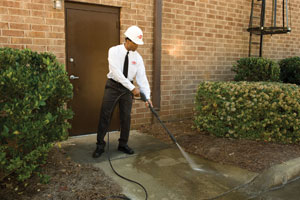
Order-up effective pest management for pizzerias
By Bill Melville
Features Business and Operations Health & SafetyEffective pest management
You may have an abundance of topping choices for pizzas, but one
ingredient you don’t want on the menu is pests. In an industry where
the customer is always right, restaurateurs should take precautions to
make sure diners don’t get a surprise with their meals.

|
| While the inside of your restaurant has the three pest needs – food, water and shelter – the outside of your establishment can also give pests a reason to stop by. Hose down outdoor areas, such as sidewalks and parking lots, to remove any debris that might attract pests.
|
You may have an abundance of topping choices for pizzas, but one ingredient you don’t want on the menu is pests. In an industry where the customer is always right, restaurateurs should take precautions to make sure diners don’t get a surprise with their meals. By implementing an effective pest management program that incorporates sanitation, pizzeria owners and operators can rest easy while delivering a quality product to every customer.
Pests are more than just a nuisance; they are a health hazard and can result in a health violation. Flies carry dangerous pathogens such as E.coli and Salmonella and transmit bacteria every time they land. Rodents can cause property damage by squeezing through holes as small as a dime, and chewing through electrical wiring inside your establishment. Since pests can cause illnesses ranging from food poisoning to pneumonia, an infestation should not be taken lightly.
To establish a successful pest management program, you must understand the basics of pest behaviour. Foodservice establishments attract pests seeking out food, water and shelter – pizzerias provide ample supply of each. By managing the elements that draw pests to your restaurant, you can ultimately reduce pests.
Integrated Pest Management (IPM) programs focus on identifying the reasons pests enter an establishment in the first place and utilize alternative pest management methods, such as stringent sanitation and facility maintenance, to make an environment less attractive. Using this proactive approach to pest management, IPM employs more environmentally friendly techniques and limits the need for chemical treatments.
Work with your pest management professional to incorporate the following tips into your IPM program to keep pests out of your pizzeria.
Don’t wait until after diners leave to begin your sanitation routine. Clean throughout the day to reduce the amount of work at closing time and eliminate food or water sources that can attract pests during the day. Wipe down tables and chairs after each guest leaves. Clean up spills immediately, even if it is just water. Mice need only a few drops to stay alive in your facility.
Watch out for sources of unnecessary moisture that can draw pests to your establishment. Outside, leaking air conditioners and rain puddles can attract pests looking for sustenance. Work with an HVAC or maintenance professional to quickly fix any problems. Eliminate standing water, which can also serve as a mosquito breeding site. Inside, spillage and condensation from ice machines and soda fountains are just as appealing to pests in need of water.
Pests see our trash as a five-star meal. Frequently empty trash receptacles within your restaurant, and if necessary, create a schedule for waste removal. Letting trash collect outside your building is a welcome invitation to pests looking for a quick bite to eat. Keep dumpsters, a pest favourite, covered at all times and as far away from your building as possible. Clean and rotate dumpsters regularly to eliminate pests or residue that might attract them.
With the heavy traffic restaurants receive each day, the floors and corners of your pizzeria can easily gather dust, crumbs and other debris. Sweep under tables after each customer and mop floors at the end of each night, especially in kitchen areas. Use an organic cleaner in floor drains to remove any buildup that flies use as a breeding ground. For hard to reach cracks and crevices, a HEPA (high efficiency particulate air) filter vacuum can remove crumbs that sweeping might have missed.
Pay attention to the area surrounding your restaurant as well. Hose down sidewalks and parking areas to remove any food debris that might interest pests. Request that your employees monitor for pests in these areas, in addition to your restaurant’s interior. Keep doors closed, especially those near shipment receiving areas and entryways to the kitchen. These are the two places pests are likely to frequent.
The storage room is known as another hot spot for pests. Store all products on open-back shelving, off the ground, and at least half a metre from walls to allow easy access for inspection and cleaning. Inspect incoming shipments for signs of pests, such as droppings, before placing them in storage. Rotate products on a first-in, first-out (FIFO) basis to keep fresh products available. Wherever possible, eliminate any cardboard boxes that can provide excellent hiding places for insect pests.
Create a written sanitation program for your pizzeria that includes daily, weekly and monthly benchmarks for your staff. Incorporating these steps into your routine not only helps keep pests at bay, but can also help protect your relationship with customers and your restaurant’s reputation. Work closely with your pest management professional to establish a strong partnership. A reputable provider can train your staff to identify the elements that attract pests and provide tips on how to prevent them. With a sanitation plan in hand and a team approach to pest management, you and your staff can keep pests off the menu and your customers happy.
Bill Melville is Quality Assurance Director for Orkin PCO Services. Mr. Melville has 35 years of experience in the industry and is an acknowledged leader in the field of pest management. For more information, e-mail Mr. Melville at bmelville@pcocanada.com or visit www.orkincanada.com .
Print this page